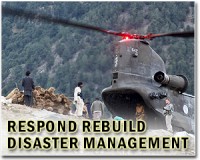| . |  |
. |
Southampton, UK (SPX) Nov 26, 2010 Southampton scientists along with colleagues in New Zealand have used a sophisticated optical mapping technique to identify and accurately measure changes in coastal morphology following a catastrophic series of landslides. "Our findings are important for assessing geological hazards and reducing the dangers to human settlements," said geophysicist Professor Jon Bull of the University of Southampton's School of Ocean and Earth Science based at the National Oceanography Centre, Southampton, Matata is a small coastal town located on the Bay of Plenty at the northern end of New Zealand's North Island close to a highly active volcanic zone. On 18 May 2005, the town was inundated by devastating debris flows. These flows resulted from torrential rain that triggered widespread landslips in the catchments of the Awatarariki and Waitepuru streams in the steeply rising hills behind the town. Debris flows are liquefied landslides of water-saturated material that flow very rapidly down steep-sided channels. In the case of the 2005 Matata event, boulders, logs and other debris were carried by the flows, which also swept away cars and even whole buildings, although fortunately no-one was killed. The material eventually spilt out along the coast where it was deposited to form a large fan-like sediment deposit. To help understand the complex pattern of sediment deposition, the researchers compared information obtained using a technique called Light Detection and Ranging technology (LIDAR) before and after the 2005 event. "LIDAR uses the time taken for reflected light to return from objects or surfaces to determine the range, in a similar manner to radar. It can be used to monitor coastal evolution, and to identify and precisely measure landform changes resulting from geological events such as landslides," explained Helen Miller, who worked on the project during her MSc project, and is now a PhD student at Southampton. Based on LIDAR, eye-witness accounts, field investigations and aerial photographic surveys, theresearchers estimate that debris flows sourced in the Awatarariki stream transported at least 350,000 cubic metres of debris. The researchers were able to map the sediment flow paths in detail, along with changes caused by the clear-up operation and the creation of man-made levees after the debris flow event. Their observations show that the final shape of the debris fan, as well as spatial differences in make-up and consistency, were largely influenced by existing physical features such as sand dunes. "The use of LIDAR for debris flow hazard analysis is still in its early days, but it has the advantage of giving a synoptic view over a large area." said Bull. "Ours is one of the first studies using 'before and after' comparisons of LIDAR data to assess changes in coastal morphology." The researchers are Jon Bull, Helen Miller and Justin Dix (SOES), Darren Gravley (Universityof Canterbury, Christchurch),Daniel Costello and Dan Hikuroa (University of Auckland). Helen Miller was supported by the University of Southampton (Richard Newitt Bursary) and the Society for Underwater Technology (Educational Support Fund). Bull, J. M., Miller, H., Gravley, D. M., Costello, D., Hikuroa, D. C. H. and Dix, D. K. Assessing debris flows using LIDAR differencing: 18 May 2005 Matata event, New Zealand. Geomorphology 124, 75-84 (2010). doi:10.1016/j.geomorph.2010.08.011
Share This Article With Planet Earth
Related Links National Oceanography Centre Bringing Order To A World Of Disasters A world of storm and tempest When the Earth Quakes
 Finnish know-how can solve global problems: Nokia chief
Finnish know-how can solve global problems: Nokia chiefHelsinki (AFP) Nov 25, 2010 Finland has the skills and responsibility to show the world how to solve some of its most critical problems, the head of one of the country's leading companies, Nokia chairman Jorma Ollila, said Thursday. Speaking at an event publicising a new national branding strategy, he said, "Finland is a country with strengths and skills in the areas where these talents are most needed in the world tod ... read more |
|
| The content herein, unless otherwise known to be public domain, are Copyright 1995-2010 - SpaceDaily. AFP and UPI Wire Stories are copyright Agence France-Presse and United Press International. ESA Portal Reports are copyright European Space Agency. All NASA sourced material is public domain. Additional copyrights may apply in whole or part to other bona fide parties. Advertising does not imply endorsement,agreement or approval of any opinions, statements or information provided by SpaceDaily on any Web page published or hosted by SpaceDaily. Privacy Statement |